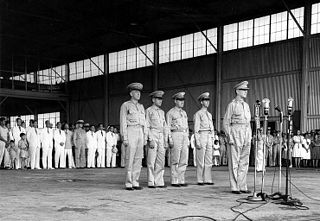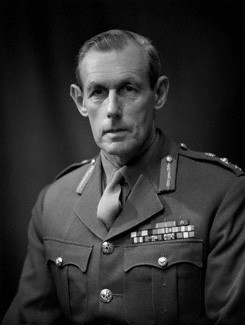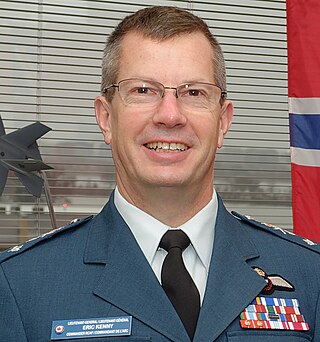Related Research Articles

United States Army Forces in the Far East (USAFFE) was a military formation of the United States Army active from 1941 to 1946. The new command's headquarters was created on 26 July 1941, at No. 1, Calle Victoria, Manila, Luzon, the Philippines, with General Douglas MacArthur as commander. The Chief of Staff was Brigadier General Richard K. Sutherland and the Deputy Chief of Staff was Lieutenant Colonel Richard J. Marshall. The core of this command was drawn from the Office of the Military Advisor to the Commonwealth Government of the Philippines.

Field Marshal Richard Michael Power Carver, Baron Carver, was a senior British Army officer. Lord Carver served as the Chief of the General Staff (CGS), the professional head of the British Army, and then as the Chief of the Defence Staff (CDS), the professional head of the British Armed Forces. He served with distinction during the Second World War and organised the administration of British forces deployed in response to the Mau Mau Uprising in Kenya and later in his career provided advice to the British government on the response to the early stages of The Troubles in Northern Ireland.
Commandant is a title often given to the officer in charge of a military training establishment or academy. This usage is common in English-speaking nations. In some countries it may be a military or police rank. It is also often used to refer to the commander of a military prison or prison camp.

Lemuel Cornick Shepherd Jr. was a General in the United States Marine Corps, 20th Commandant of the Marine Corps, Navy Cross recipient, veteran of World War I, World War II, and the Korean War.

A military staff or general staff is a group of officers, enlisted and civilian staff who serve the commander of a division or other large military unit in their command and control role through planning, analysis, and information gathering, as well as by relaying, coordinating, and supervising the execution of their plans and orders, especially in case of multiple simultaneous and rapidly changing complex operations. They are organised into functional groups such as administration, logistics, operations, intelligence, training, etc. They provide multi-directional flow of information between a commanding officer, subordinate military units and other stakeholders. A centralised general staff results in tighter top-down control but requires larger staff at headquarters (HQ) and reduces accuracy of orientation of field operations, whereas a decentralised general staff results in enhanced situational focus, personal initiative, speed of localised action, OODA loop, and improved accuracy of orientation.

General Henry Duncan Graham Crerar was a senior officer of the Canadian Army who became the country's senior field commander in the Second World War as commander of the First Canadian Army in the campaign in North West Europe in 1944–1945. A graduate of the Royal Military College of Canada, in Kingston, Ontario, Crerar was commissioned as a lieutenant in the Non-Permanent Active Militia in 1909, serving with the 4th Battery, Canadian Field Artillery, which was based in Hamilton, Ontario. He rose to the rank of lieutenant-colonel in the artillery in the First World War, during which he was mentioned in despatches and made a member of the Distinguished Service Order (DSO). Electing to remain in the army as a professional soldier after the war, he attended the Staff College, Camberley, from 1923 to 1924, and the Imperial Defence College in 1934. He was appointed Director of Military Operations & Military Intelligence in 1935 and Commandant of the Royal Military College of Canada in 1939.

Lieutenant-General Guy Granville Simonds, was a senior Canadian Army officer who served with distinction during World War II. Acknowledged by many military historians and senior commanders, among them Sir Max Hastings and Field Marshal Sir Bernard Montgomery, as one of the best Canadian generals of the war, Simonds, after serving the first few years of the Second World War mainly as a staff officer, commanded the 1st Canadian Infantry Division with distinction in Sicily and Italy from July 1943 until January 1944, and later II Canadian Corps during the Battle of Normandy from June−August 1944 and throughout the subsequent campaign in Western Europe from 1944, towards the end of which he temporarily commanded the First Canadian Army during the Battle of the Scheldt, until victory in Europe Day in May 1945. The historian J. L. Granatstein states the following about Simonds: "No Canadian commander rose higher and faster in the Second World War, and none did as well in action. Simonds owed his success wholly to his own abilities and efforts—and those of the men who served under him."
Colonel commandant is a military title used in the armed forces of some English-speaking countries. The title, not a substantive military rank, could denote a senior colonel with authority over fellow colonels. Today, the holder often has an honorary role outside the executive military structure, such as advocacy for the troops.
Major-General John Sydney Lethbridge CB, CBE, MC was a British soldier.

The Corp of Sri Lanka Engineers (SLE) is a combat support arm of the Sri Lanka Army which provides military engineering. It is made up of ten regular regiments and one volunteer regiment. Headquartered at Panagoda Cantonment, it is headed by the Centre Commandant.

General Sir William Godfrey Fothergill Jackson, was a British Army officer, military historian, author and Governor of Gibraltar.

Air Chief Marshal Sir Arthur Sheridan Barratt, was an officer in the Royal Flying Corps during the First World War and a senior commander in the Royal Air Force during the Second World War. He acquired the nickname "Ugly".
Lieutenant General Sir Henry Wells, was a senior officer in the Australian Army. Serving as Chief of the General Staff from 1954 to 1958, Wells' career culminated with his appointment as the first Chairman, Chiefs of Staff Committee, a position marking him as the professional head of the Australian Military. He served in this capacity from March 1958 until March 1959, when he retired from the army.

General Sir Charles Leslie Richardson, was a senior British Army officer who saw service in the Second World War and reached high office in the 1950s.

General Sir Charles Phibbs Jones, was a British Army officer who reached high office in the 1950s.
Lieutenant-General William Alexander Beaumont Anderson OBE, CD was the Commander, Mobile Command of the Canadian Forces.

Lieutenant General Sir Humfrey Myddelton Gale, was an officer in the British Army who served in the First and Second World War, during which he was Chief Administrative Officer at Allied Forces Headquarters and later SHAEF under General Dwight D. Eisenhower. After the Second World War he was European Director of the United Nations Relief and Rehabilitation Administration, worked for the Anglo-Iranian Oil Company, and was chairman of the Basildon, Essex New Town Development Corporation

The Commander of the Royal Canadian Air Force is the institutional head of the Royal Canadian Air Force. This appointment also includes the title Chief of the Air Force Staff and is based at National Defence Headquarters in Ottawa, Ontario.
Major General Jagath Gunawardena, RSP, VSV, USP was a Sri Lankan senior army general. He was the Chief of Staff of the Sri Lankan Army, having served as the Commandant of the Volunteer Force, Commander, Security Forces Headquarters – Wanni and Master General of Ordnance. He served as the Colonel Commandant of the Sri Lanka Engineers.
Major-General John Castle Woollett, was a British Army officer. He joined the Royal Engineers in 1935 and studied for a degree in mechanical sciences at St John's College, Cambridge. Woollett joined the British Expeditionary Force (BEF) in France in September 1939, at the start of the Second World War. After the BEF was evacuated to the United Kingdom in 1940 he volunteered for commando service. Woollett commanded the demolition engineers in Operation Archery, a 1941 raid on Vågsøy in German-occupied Norway. He commanded 16 Field Squadron, an armoured engineer unit, from 1942. With the 79th Armoured Division he took part in the North-West Europe campaign of 1944–45, assisting with river crossings and demolition of German strongholds, and won the Military Cross.